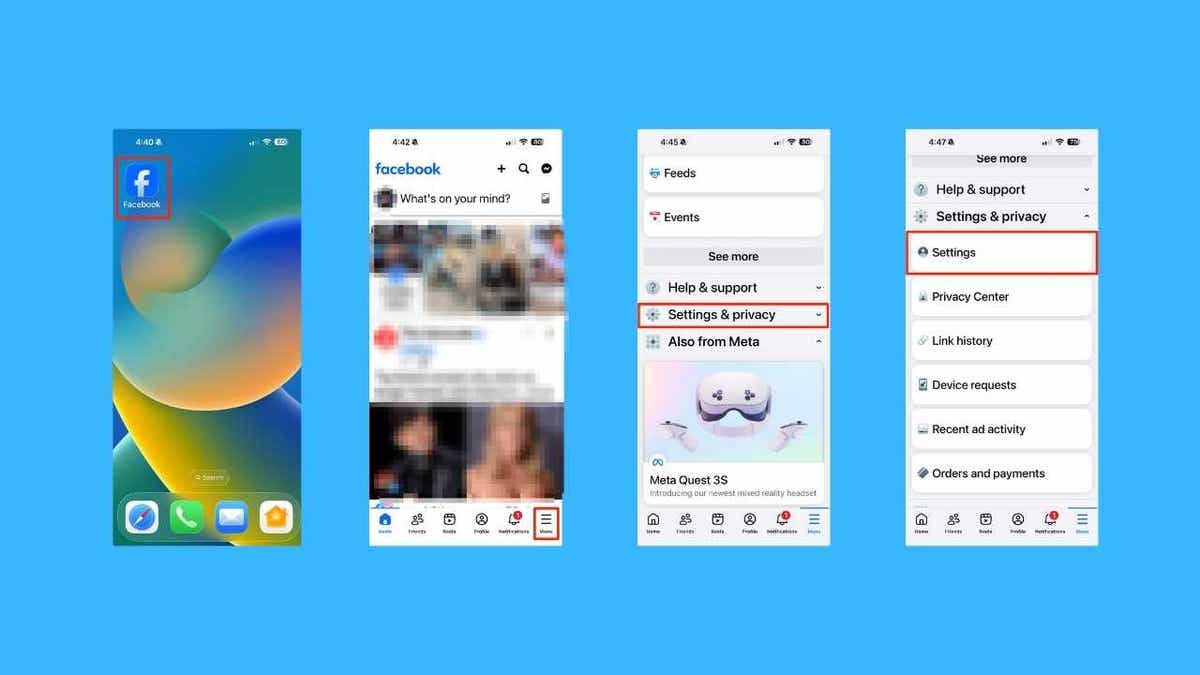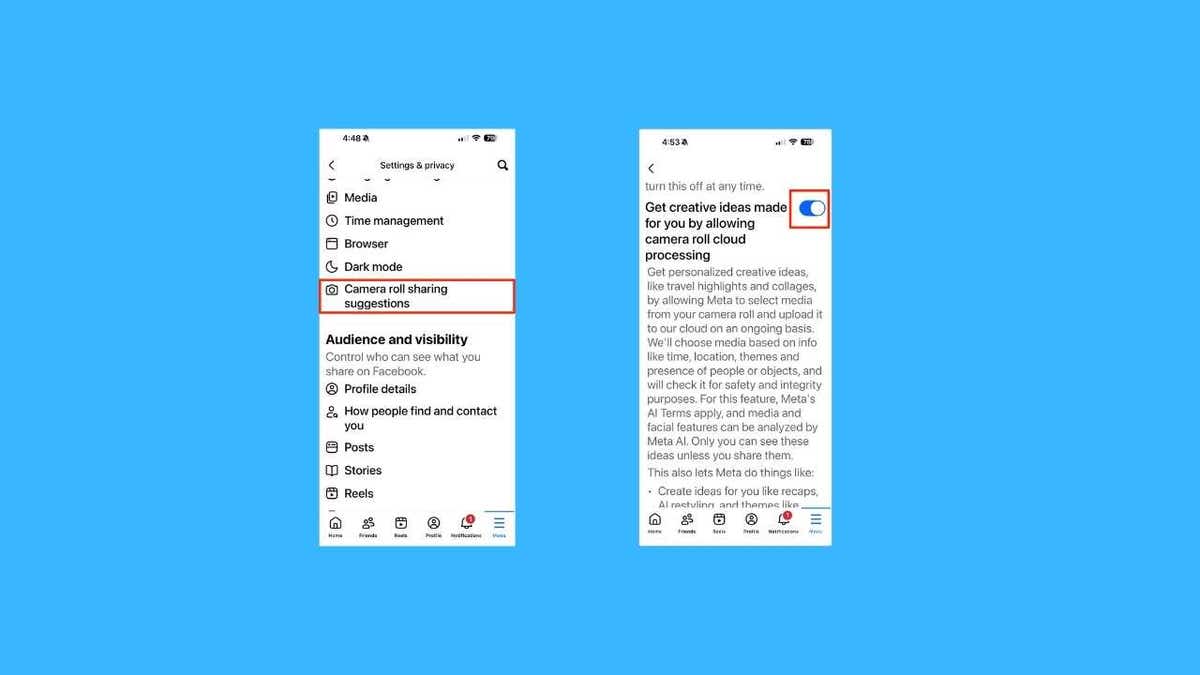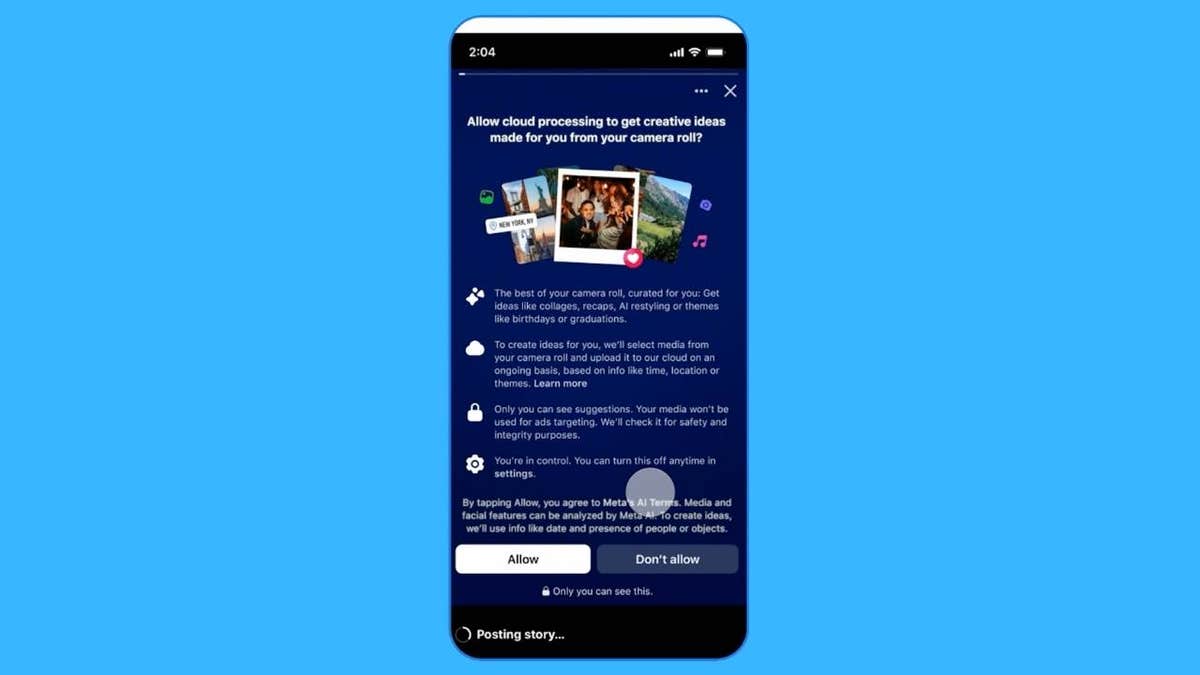Technology
Meta AI edits your camera roll for better Facebook posts

NEWYou can now listen to Fox News articles!
Your phone is full of photos you’ve never posted, moments you meant to share but never got around to. That’s exactly what Facebook wants to change. It now uses Meta AI to spot hidden gems in your camera roll, polish them, and create simple collages you can share. You take the pictures, and Facebook helps turn them into easy, ready-to-share memories. No design skills required.
Sign up for my FREE CyberGuy Report
Get my best tech tips, urgent security alerts and exclusive deals delivered straight to your inbox. Plus, you’ll get instant access to my Ultimate Scam Survival Guide – free when you join my CYBERGUY.COM newsletter.
Why Meta created this AI photo feature
Many people take photos but then don’t share them because they feel the image isn’t “post-worthy,” or they simply don’t have time to make it look good. Meta’s logic: if those moments are sitting unseen in your phone, screenshots, receipts, random snaps, they might still matter to you. So the tool helps you rediscover and share them. From Meta’s perspective, this also fits its bigger push into artificial intelligence-driven features across its apps.
LEAKED META DOCUMENTS SHOW HOW AI CHATBOTS HANDLE CHILD EXPLOITATION
New AI tool scans your camera roll to find and polish images for quick sharing. (Kurt “CyberGuy” Knutsson)
Behind the scenes, Meta AI analyzes photo details, like lighting, people and events, to group similar moments and create polished collage layouts automatically. It can suggest captions or filters, but users can edit or reject any suggestion before posting.
How to enable the Facebook AI feature
Here’s how to turn this feature on in Facebook (and how to disable it if you prefer).
- Open the Facebook app on your phone (iOS or Android).
- Tap your profile picture or the menu icon.
- Go to Settings & Privacy.
- Click Settings.
META STRENGTHENS TEEN SAFETY WITH EXPANDED ACCOUNTS

Meta aims to revive old memories with Facebook’s AI-powered collage creator. (Kurt “CyberGuy” Knutsson)
- Scroll to Preferences (or something similar) and find Camera Roll Sharing Suggestions and tap on it.
- Toggle on ‘Get creative ideas made for you by allowing camera roll cloud processing’ (or similar wording). You may be prompted to allow “cloud processing,” whereby Facebook uploads photos from your device to its servers so Meta AI can analyze them.
INSTAGRAM FRIEND MAP FEATURE SPARKS PRIVACY QUESTIONS

Users can now let Facebook’s AI curate camera roll highlights automatically. (Kurt “CyberGuy” Knutsson)
- Confirm the opt-in and accept any permission prompts. Once enabled, Meta claims that only you see suggestions, and you decide if you save or share them.
META DELETES 10 MILLION FACEBOOK ACCOUNTS THIS YEAR, BUT WHY?

Facebook rolls out AI photo suggestions to make sharing easier than ever. (Kurt “CyberGuy” Knutsson)
You’ll also receive optional notifications when new collage suggestions are ready, giving you the chance to preview and edit them before sharing.
Steps to disable or opt out
- Follow the same path: Facebook app → Settings & Privacy → Settings → Preferences → Camera Roll Sharing Suggestions.
- Toggle the feature off or disable “cloud processing.”
- For extra privacy, you can also revoke Facebook’s access to your camera roll in your phone’s OS settings.
If you’ve already uploaded photos for analysis, Meta says you can delete that data by turning off the feature and clearing saved files under “Your Facebook Information” in Settings.
What this means for you
Here’s how Facebook’s new AI photo feature could change the way you share, save and see your favorite moments online.
- More sharing without the effort. You capture the moment, Facebook helps polish it. The barrier of “this photo isn’t good enough” gets lowered.
- Greater visibility for memories. That vacation scrapbook photo or family snap buried in your camera roll might now get a second life.
- Full control remains. You decide whether to share the suggested edit or keep it private. Meta emphasizes that the suggestions are shown only to you unless you choose to share.
- Privacy considerations. Even though Meta says your photos won’t be used to train AI unless you edit or share them, they do get uploaded to Meta’s cloud when you opt in and may be stored for some time. Meta confirms that the uploaded photos aren’t used for ad targeting or facial recognition, but they may be stored temporarily for processing before being deleted.
- Limited rollout. At present, U.S. and Canada only; international users may need to wait.
Take my quiz: How safe is your online security?
Think your devices and data are truly protected? Take this quick quiz to see where your digital habits stand. From passwords to Wi-Fi settings, you’ll get a personalized breakdown of what you’re doing right and what needs improvement. Take my Quiz here: Cyberguy.com.
Kurt’s key takeaways
This move by Facebook addresses a common pain point (photos that don’t get shared) and leverages AI to make sharing more effortless. If you’re an active Facebook user who takes many photos and wants to share more of them, this feature could be a welcome boost. But if you’re cautious about how your private media may be handled, the opt-out path is important and worth using. Either way, it reflects how AI is quietly reshaping everyday apps.
Will you turn on Facebook’s AI-powered photo suggestion feature or keep your camera roll private just the way it is? Let us know by writing to us at Cyberguy.com.
Sign up for my FREE CyberGuy Report
Get my best tech tips, urgent security alerts and exclusive deals delivered straight to your inbox. Plus, you’ll get instant access to my Ultimate Scam Survival Guide – free when you join my CYBERGUY.COM newsletter.
Copyright 2025 CyberGuy.com. All rights reserved.

Technology
The government shutdown is delaying new gadgets

Tech products that are packaged and ready for sale aren’t launching in the US as planned right now, thanks to the government shutdown.
Earlier this month, Leica delayed its M EV1 camera due to holdups on approval from the partially shuttered Federal Communications Commission (FCC). The WiiM Sound audiophile speaker, currently shipping in international markets, has been delayed in the US for the same reason. Razer also delayed the US availability of its Raiju V3 Pro wireless controller, saying that it’s waiting on clearance. Numerous other devices might be in the same boat, and the longer the shutdown stretches, the worse the backlog will get.
Any product that emits radio frequencies cannot be sold in the US until the FCC provides clearance, ensuring the emissions fall within approved frequencies and don’t cause interference with other devices. Typically, this is a routine process. But because it’s not considered an essential function of the agency, as the government shutdown enters its 27th day, manufacturers are facing a growing backlog with no end in sight, says Harold Feld, SVP at Public Knowledge. “You can’t get them off the boats until they have their certification,” Feld tells The Verge.
Government shutdowns have impacted FCC approval in past years, but even if the shutdown ends soon, the application queue likely won’t be cleared as quickly as companies hope. “The FCC has lost a large number of engineers as a result of retirement,” Feld says. While he believes it mostly avoided the purge that befell some other agencies under Elon Musk’s Department of Government Efficiency, he says it’s still dealing with an aging, dwindling workforce of people to test the devices it approves.
More disruptive yet is how the FCC under the Trump administration is reshaping its rules, which could lead to unexpected product delays and confusion. On September 8th, the agency decertified numerous Chinese testing labs that companies used to verify that their products’ radio frequency emissions met FCC standards. FCC Chairman Brendan Carr boasted that these “Bad Labs” were decertified as a step in “restoring trust in the Commission’s equipment authorization process, and combatting foreign adversary threats.” But it means companies need to add one more step to their process: “You have to go and find another lab that has still got its certification in order to certify your product,” says Feld.
Finding a different lab to get FCC clearance may still be only a short-term fix, because the agency will meet on October 28th, per the FCC’s agenda, to discuss further modifying which labs are authorized and which present what it dubs national security threats. Feld expects that the agency may further screen out more labs and change rules, both of which could spell unexpected hurdles in product release timelines, including longer waits for regulatory clearances.
“The fact that the rules, to a certain degree, are in flux, makes it harder for companies to project going forward what they’re going to need to do,” Feld says.
Before the shutdown, companies gearing up for a big holiday-timed product launch sought FCC certification months in advance. However, more companies may feel the need to adopt proactive plans to factor in the possible delays in dealing with the FCC. That likely presents a big adjustment for many companies, as they may need to lock in final manufacturing samples earlier in the product development process.
We reached out to the FCC asking whether the government shutdown was to blame for impacting its ability to provide clearances for tech products. It auto-responded with an email saying that it can’t answer emails because of the government shutdown.
Technology
Tesla revives ‘Mad Max’ mode in Full Self-Driving

NEWYou can now listen to Fox News articles!
Tesla is making headlines again with the return of its Mad Max mode in Full Self-Driving (Supervised). This feature, designed to make the car drive more aggressively, has arrived just as the automaker faces new scrutiny from regulators and ongoing lawsuits from customers.
Sign up for my FREE CyberGuy Report
Get my best tech tips, urgent security alerts and exclusive deals delivered straight to your inbox. Plus, you’ll get instant access to my Ultimate Scam Survival Guide – free when you join my CyberGuy.com newsletter.
Mad Max Mode returns in Tesla’s latest FSD update
Tesla recently launched its FSD v14.1.2 update. The update follows last year’s major FSD v14 release, which introduced “Sloth Mode” for slower, more cautious driving. The latest update moves to the opposite end of the spectrum with Mad Max mode.
According to Tesla’s release notes, this profile allows higher speeds and more frequent lane changes than Hurry mode. The update has sparked mixed reactions. Some Tesla fans praise it for making driving feel more natural. Critics argue that it invites risky behavior at a time when regulators like the NHTSA and California DMV are already investigating Tesla’s advanced driver-assist systems.
TESLA’S SELF-DRIVING CARS UNDER FIRE AGAIN
A new Mad Max speed profile is now included in Tesla’s Full Self-Driving interface. (Tesla)
History of Tesla’s Mad Max mode since 2018
The Mad Max setting isn’t new. Tesla first introduced it in 2018 for the original Autopilot system. At the time, Elon Musk described it as ideal for handling aggressive city traffic. The name, borrowed from the post-apocalyptic movie series, immediately drew attention for its bold tone.
Now, the feature is back in Tesla’s latest FSD version. Within hours of release, drivers reported seeing cars equipped with Mad Max mode rolling stop signs and driving over the speed limit. These early reports highlight how the mode may behave more assertively than before.
Why Tesla brought back its Mad Max mode
Bringing back Mad Max mode may serve several purposes for Tesla. It helps demonstrate the company’s continuous development of FSD software while appealing to drivers who prefer faster, more decisive movement in traffic. It also acts as a signal that Tesla is still chasing the goal of Level 4 autonomy, even though its system remains classified as Level 2, requiring constant driver supervision.

Tesla owners can access Mad Max mode through the car’s settings under Speed Profiles. (Chesnot/Getty Images)
For Tesla, this feature shows confidence in its progress. For observers, it raises concerns about timing. With multiple investigations and lawsuits in progress, many expected Tesla to focus on safety rather than on more aggressive driving profiles.
What this means for you
If you own a Tesla with Full Self-Driving (Supervised), you can access Mad Max mode through the car’s settings under Speed Profiles. This mode provides a more assertive driving experience that includes quicker acceleration, more lane changes, and less hesitation.
However, remember that Tesla’s Full Self-Driving system still requires active driver attention. You must keep your hands on the wheel and remain ready to take control at any moment. While the name suggests thrill and speed, safety and awareness should remain your top priority.

Tesla’s speed-profile menu includes the toggle options of Chill, Standard, Hurry, and Mad Max profiles to customize how aggressively their car responds in traffic. (REUTERS/Mike Blake)
If you share the road with Teslas, it’s smart to stay alert. Vehicles using Mad Max mode may accelerate or change lanes more quickly than expected. Giving Teslas a little extra space can help reduce surprises and keep everyone safer on the road.
Take my quiz: How safe is your online security?
Think your devices and data are truly protected? Take this quick quiz to see where your digital habits stand. From passwords to Wi-Fi settings, you’ll get a personalized breakdown of what you’re doing right and what needs improvement. Take my Quiz here: CyberGuy.com.
WOULD YOU BUY THE WORLD’S FIRST PERSONAL ROBOCAR?
Kurt’s key takeaways
Tesla’s decision to reintroduce Mad Max mode is both strategic and provocative. It revives a feature from its early Autopilot days while reigniting debate over the balance between innovation and responsibility. The mode’s return reminds everyone that Tesla continues to test the limits of driver-assist technology and public tolerance for it.
Will Tesla’s revived Mad Max mode mark a bold step toward autonomy or a dangerous gamble in the race for self-driving dominance? Let us know by writing to us at CyberGuy.com
Sign up for my FREE CyberGuy Report
Get my best tech tips, urgent security alerts and exclusive deals delivered straight to your inbox. Plus, you’ll get instant access to my Ultimate Scam Survival Guide – free when you join my CyberGuy.com newsletter.
CLICK HERE TO DOWNLOAD THE FOX NEWS APP
Copyright 2025 CyberGuy.com. All rights reserved.
Technology
‘There isn’t really another choice:’ Signal chief explains why the encrypted messenger relies on AWS

After last week’s major Amazon Web Services (AWS) outage took Signal along with it, Elon Musk was quick to criticize the encrypted messaging app’s reliance on big tech. But Signal president Meredith Whittaker argues that the company didn’t have any other choice but to use AWS or another major cloud provider.
“The problem here is not that Signal ‘chose’ to run on AWS,” Whittaker writes in a series of posts on Bluesky. “The problem is the concentration of power in the infrastructure space that means there isn’t really another choice: the entire stack, practically speaking, is owned by 3-4 players.”
In the thread, Whittaker says the number of people who didn’t realize Signal uses AWS is “concerning,” as it indicates they aren’t aware of just how concentrated the cloud infrastructure industry is. “The question isn’t ‘why does Signal use AWS?’” Whittaker writes. “It’s to look at the infrastructural requirements of any global, real-time, mass comms platform and ask how it is that we got to a place where there’s no realistic alternative to AWS and the other hyperscalers.”
Whittaker notes that AWS, Microsoft Azure, and Google’s cloud services are the only viable options that Signal can use to provide reliable service on a global scale without spending billions of dollars to build its own. “Running a low-latency platform for instant comms capable of carrying millions of concurrent audio/video calls requires a pre-built, planet-spanning network of compute, storage and edge presence that requires constant maintenance, significant electricity and persistent attention and monitoring,” Whittaker says.
She adds that Signal only “partly” runs on AWS and uses encryption to ensure Signal and AWS can’t see your conversations. Signal was far from the only company affected by the AWS outage, as it also brought down Starbucks, the Epic Games Store, Ring doorbells, Snapchat, Alexa devices, and even smart beds.
“My silver lining hope is that AWS going down can be a learning moment, in which the risks of concentrating the nervous system of our world in the hands of a few players become very clear,” Whittaker writes.
-

 New York5 days ago
New York5 days agoVideo: How Mamdani Has Evolved in the Mayoral Race
-

 World1 week ago
World1 week agoIsrael continues deadly Gaza truce breaches as US seeks to strengthen deal
-

 News7 days ago
News7 days agoVideo: Federal Agents Detain Man During New York City Raid
-

 News7 days ago
News7 days agoBooks about race and gender to be returned to school libraries on some military bases
-

 Technology1 week ago
Technology1 week agoAI girlfriend apps leak millions of private chats
-

 Politics1 week ago
Politics1 week agoTrump admin on pace to shatter deportation record by end of first year: ‘Just the beginning’
-

 Business1 week ago
Business1 week agoUnionized baristas want Olympics to drop Starbucks as its ‘official coffee partner’
-

 News1 week ago
News1 week agoTrump news at a glance: president can send national guard to Portland, for now
















